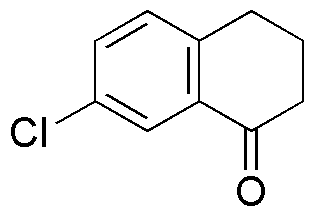7-Chloro-1-tetralone is widely utilized in research focused on:
- Synthesis of Pharmaceuticals: This compound serves as a key intermediate in the synthesis of various pharmaceutical agents, particularly in the development of anti-inflammatory and analgesic drugs.
- Organic Chemistry Research: It is often used in organic synthesis as a building block for creating more complex molecules, aiding researchers in exploring new chemical reactions and pathways.
- Material Science: The compound can be incorporated into polymer formulations, enhancing properties such as thermal stability and mechanical strength, making it valuable in the production of advanced materials.
- Biological Studies: Researchers utilize it to study its biological activity, particularly in relation to its effects on various cellular processes, which can lead to the discovery of new therapeutic targets.
- Analytical Chemistry: It serves as a standard reference material in analytical methods, helping laboratories ensure the accuracy and reliability of their testing procedures.
Información general
Propiedades
Seguridad y normativas
Aplicaciones
7-Chloro-1-tetralone is widely utilized in research focused on:
- Synthesis of Pharmaceuticals: This compound serves as a key intermediate in the synthesis of various pharmaceutical agents, particularly in the development of anti-inflammatory and analgesic drugs.
- Organic Chemistry Research: It is often used in organic synthesis as a building block for creating more complex molecules, aiding researchers in exploring new chemical reactions and pathways.
- Material Science: The compound can be incorporated into polymer formulations, enhancing properties such as thermal stability and mechanical strength, making it valuable in the production of advanced materials.
- Biological Studies: Researchers utilize it to study its biological activity, particularly in relation to its effects on various cellular processes, which can lead to the discovery of new therapeutic targets.
- Analytical Chemistry: It serves as a standard reference material in analytical methods, helping laboratories ensure the accuracy and reliability of their testing procedures.
Documentos
Hojas de datos de seguridad (HDS)
La SDS proporciona información de seguridad completa sobre la manipulación, el almacenamiento y la eliminación del producto.
Especificación del producto (PS)
La PS proporciona un desglose completo de las propiedades del producto, incluida la composición química, el estado físico, la pureza y los requisitos de almacenamiento. También detalla los rangos de calidad aceptables y las aplicaciones previstas del producto.
Certificados de análisis (COA)
Busque certificados de análisis (COA) ingresando el número de lote del producto. Los números de lote y de partida se pueden encontrar en la etiqueta de un producto después de las palabras "Lote" o "Lote".
Número de catálogo
Número de lote/lote
Certificados de origen (COO)
Este certificado de origen confirma el país en el que se fabricó el producto y también detalla los materiales y componentes utilizados en él y si se deriva de fuentes naturales, sintéticas u otras fuentes específicas. Este certificado puede ser necesario para cumplir con las normativas aduaneras, comerciales y regulatorias.
Número de catálogo
Número de lote/lote
Hojas de datos de seguridad (HDS)
La SDS proporciona información de seguridad completa sobre la manipulación, el almacenamiento y la eliminación del producto.
DownloadEspecificación del producto (PS)
La PS proporciona un desglose completo de las propiedades del producto, incluida la composición química, el estado físico, la pureza y los requisitos de almacenamiento. También detalla los rangos de calidad aceptables y las aplicaciones previstas del producto.
DownloadCertificados de análisis (COA)
Busque certificados de análisis (COA) ingresando el número de lote del producto. Los números de lote y de partida se pueden encontrar en la etiqueta de un producto después de las palabras "Lote" o "Lote".
Número de catálogo
Número de lote/lote
Certificados de origen (COO)
Este certificado de origen confirma el país en el que se fabricó el producto y también detalla los materiales y componentes utilizados en él y si se deriva de fuentes naturales, sintéticas u otras fuentes específicas. Este certificado puede ser necesario para cumplir con las normativas aduaneras, comerciales y regulatorias.


